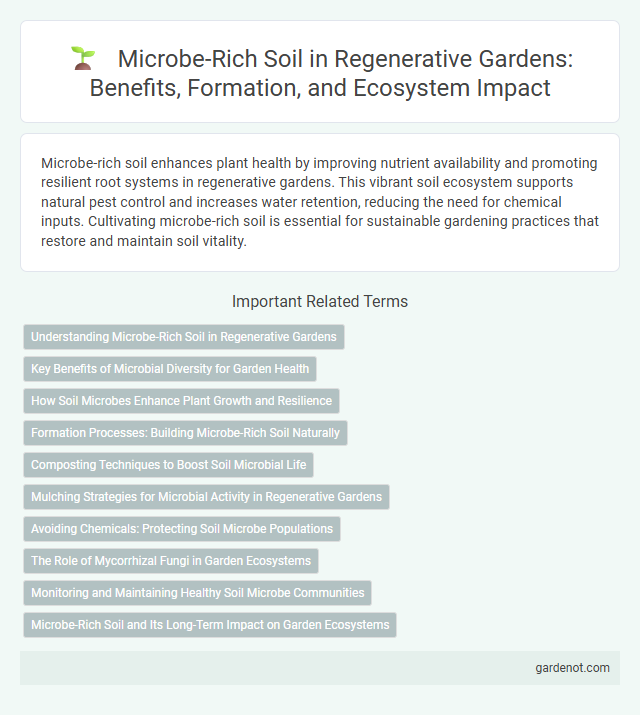Microbe-rich soil enhances plant health by improving nutrient availability and promoting resilient root systems in regenerative gardens. This vibrant soil ecosystem supports natural pest control and increases water retention, reducing the need for chemical inputs. Cultivating microbe-rich soil is essential for sustainable gardening practices that restore and maintain soil vitality.
Understanding Microbe-Rich Soil in Regenerative Gardens
Microbe-rich soil in regenerative gardens enhances nutrient cycling, improves soil structure, and boosts plant resilience through diverse microbial communities including bacteria, fungi, and protozoa. These microorganisms break down organic matter, fix atmospheric nitrogen, and suppress pathogens, creating a healthy, self-sustaining ecosystem. Understanding the balance and function of soil microbes enables gardeners to optimize composting, mulching, and crop rotation for improved soil fertility and plant growth.
Key Benefits of Microbial Diversity for Garden Health
Microbe-rich soil enhances nutrient cycling by breaking down organic matter, making essential nutrients more accessible to plants. Diverse microbial populations improve soil structure and water retention, reducing erosion and increasing drought resilience. Beneficial microbes also suppress pathogens, promoting plant health and reducing the need for chemical fertilizers and pesticides.
How Soil Microbes Enhance Plant Growth and Resilience
Soil microbes play a crucial role in regenerative gardens by breaking down organic matter to release essential nutrients, improving soil structure and aeration, and promoting root growth through symbiotic relationships such as mycorrhizal fungi. These microorganisms enhance plant resilience by boosting immunity against pathogens and increasing tolerance to environmental stressors like drought and heat. Studies show that microbe-rich soil can increase crop yield by up to 20%, making microbial diversity vital for sustainable plant health and productivity.
Formation Processes: Building Microbe-Rich Soil Naturally
Microbe-rich soil forms through natural processes such as organic matter decomposition, root exudation, and microbial symbiosis, which enhance soil fertility and structure. The gradual breakdown of plant residues by fungi and bacteria releases essential nutrients, promoting a diverse microbial ecosystem. This complexity supports healthy plant growth and resilience, making microbe-rich soil a cornerstone of regenerative gardening.
Composting Techniques to Boost Soil Microbial Life
Composting techniques such as vermicomposting and hot composting enhance microbe-rich soil by accelerating organic matter breakdown and increasing microbial diversity. Incorporating diverse food scraps and garden waste optimizes nutrient cycling, promoting the proliferation of beneficial bacteria and fungi essential for regenerative garden health. Regularly maintaining moisture and aeration within compost heaps further stimulates microbial activity, resulting in fertile, biologically active soil.
Mulching Strategies for Microbial Activity in Regenerative Gardens
Mulching strategies in regenerative gardens enhance microbe-rich soil by maintaining optimal moisture levels and providing organic matter that fuels microbial communities. Applying diverse organic mulches such as compost, wood chips, and leaf litter promotes fungal and bacterial growth crucial for nutrient cycling and soil structure improvement. Regularly replenishing mulch layers supports sustained microbial activity, leading to healthier plants and increased soil fertility.
Avoiding Chemicals: Protecting Soil Microbe Populations
Microbe-rich soil thrives by avoiding chemical fertilizers and pesticides, which can disrupt essential microbial communities that support nutrient cycling and plant health. Maintaining natural soil biology enhances regeneration, promoting resilience and biodiversity in garden ecosystems. Protecting these soil microbe populations ensures sustainable growth and improved soil structure over time.
The Role of Mycorrhizal Fungi in Garden Ecosystems
Mycorrhizal fungi form symbiotic relationships with plant roots, enhancing nutrient uptake and soil structure in regenerative gardens. These fungi increase the availability of phosphorus and nitrogen, crucial for plant growth, while improving water retention in microbe-rich soil. Their presence stimulates microbial diversity and resilience, promoting healthier, more sustainable garden ecosystems.
Monitoring and Maintaining Healthy Soil Microbe Communities
Monitoring soil microbe communities in a regenerative garden involves regularly assessing microbial diversity and activity using soil tests and DNA sequencing techniques. Maintaining healthy soil microbes requires incorporating organic matter, minimizing soil disturbance, and avoiding chemical inputs that disrupt microbial balance. These practices enhance nutrient cycling, improve soil structure, and support plant resilience.
Microbe-Rich Soil and Its Long-Term Impact on Garden Ecosystems
Microbe-rich soil enhances nutrient cycling by breaking down organic matter into bioavailable forms, improving soil fertility and plant health over time. The presence of diverse microbial communities boosts soil structure, water retention, and disease resistance, creating a resilient garden ecosystem. Long-term benefits include increased carbon sequestration and sustained biological activity, promoting a self-sustaining regenerative garden environment.
Microbe-rich soil Infographic

 gardenot.com
gardenot.com